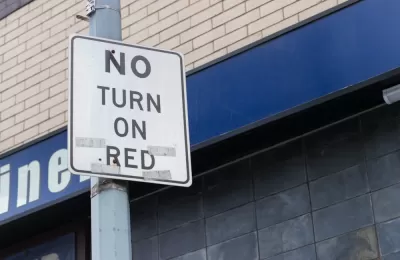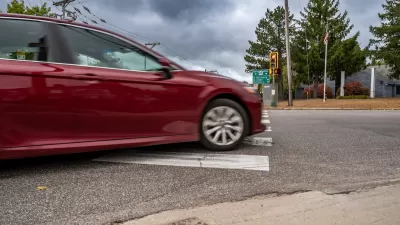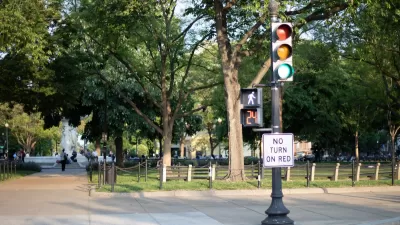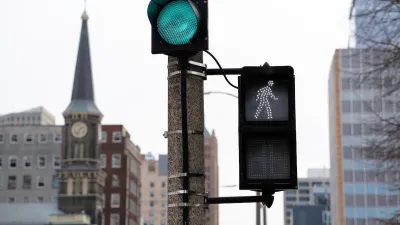How road safety activists passed a law that could make roads much safer.

In a piece for the Vision Zero Cities Journal republished in Streetsblog USA, Rebecca Serna and Jason Dozier outline how Atlanta, Georgia passed a ban on right turns on red this February in an effort to make streets in three central neighborhoods safer for pedestrians.
As the authors explain, “Research shows that turning right on red poses significant risks to people who are most vulnerable in crashes: people getting around by foot, wheelchair, and bicycle. As drivers make right turns on red lights, their attention is focused on oncoming traffic from their left — not on people walking across the street or waiting in the bike lane on their right. With their attention elsewhere, drivers are more likely to turn into people outside of cars who have the pedestrian signal to cross.”
Planetizen has covered right turns on red in previous pieces, noting that allowing right turns on red lights was largely a result of the 1970s energy crisis. However, transportation planners and policymakers are now recognizing its negative impact on road safety and working to reverse the laws that allows these turns.
In Atlanta, 65 fatalities and serious injuries occurred at intersections with legal right turns on red in the last nine years, with close to half of them happening while drivers were turning right at red lights. The effort to ban them was led by city council member Jason S. Dozier, who urged fellow council members — some of whom have experienced close calls as pedestrians themselves — to support the ban. “In an unexpected turn, we also found allies in councilmembers who drove some of the largest vehicles, who supported the effort due to near-misses they’d experienced with pedestrians.”
According to the authors, “Atlanta’s new no-right-on-red policy is a step towards real, measurable change in pedestrian safety. It’s also a chance to live out our declared values as a city that is both pedestrian-friendly and supportive of sustainable and safe ways of getting around.”
FULL STORY: How Atlanta Passed Its Right-On-Red Ban

Manufactured Crisis: Losing the Nation’s Largest Source of Unsubsidized Affordable Housing
Manufactured housing communities have long been an affordable housing option for millions of people living in the U.S., but that affordability is disappearing rapidly. How did we get here?

Americans May Be Stuck — But Why?
Americans are moving a lot less than they once did, and that is a problem. While Yoni Applebaum, in his highly-publicized article Stuck, gets the reasons badly wrong, it's still important to ask: why are we moving so much less than before?

Using Old Oil and Gas Wells for Green Energy Storage
Penn State researchers have found that repurposing abandoned oil and gas wells for geothermal-assisted compressed-air energy storage can boost efficiency, reduce environmental risks, and support clean energy and job transitions.

Updating LA’s Tree Rules Could Bring More Shade to Underserved Neighborhoods
A new USC study finds that relaxing Los Angeles’ outdated tree planting guidelines could significantly expand urban tree canopy and reduce shade disparities in lower-income neighborhoods, though infrastructure investments are also needed.

California's Canal Solar Projects Aim to Conserve Resources and Expand Clean Energy
California’s Project Nexus has begun generating electricity from solar panels installed over irrigation canals, with researchers and state agencies exploring statewide expansion to conserve water and boost clean energy production.

HHS Staff Cuts Gut Energy Assistance Program
The full staff of a federal program that distributes heating and cooling assistance for low-income families was laid off, jeopardizing the program’s operations.
Urban Design for Planners 1: Software Tools
This six-course series explores essential urban design concepts using open source software and equips planners with the tools they need to participate fully in the urban design process.
Planning for Universal Design
Learn the tools for implementing Universal Design in planning regulations.
Heyer Gruel & Associates PA
City of Moreno Valley
Institute for Housing and Urban Development Studies (IHS)
City of Grandview
Harvard GSD Executive Education
Salt Lake City
NYU Wagner Graduate School of Public Service
City of Cambridge, Maryland





























